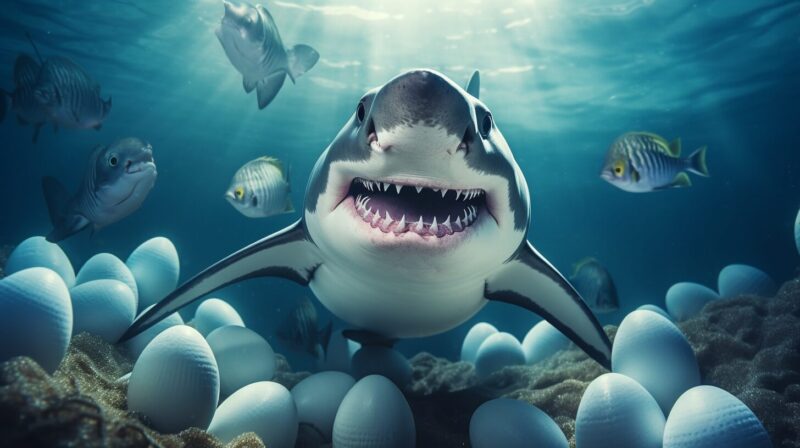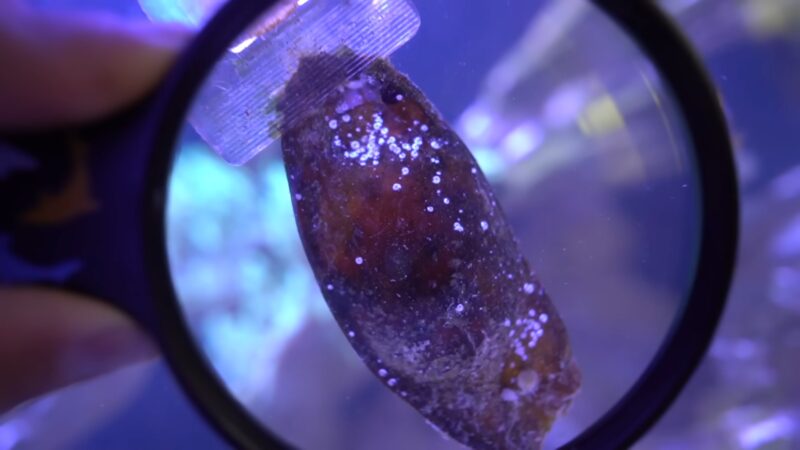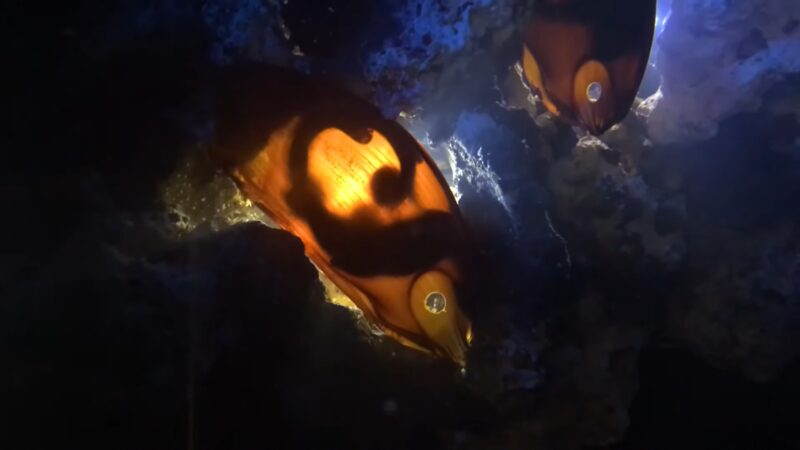Sharks, the apex predators of the ocean, have fascinated us humans for centuries. Their reproductive strategies, however, remain a mystery to many. Sharks have a diverse range of reproductive methods, with some species laying eggs and others giving birth to live young.
I’ve always wondered about their reproduction; do they lay eggs or not? What happens there?
The diversity of shark reproductive strategies reflects their adaptation to different environments. Some species lay eggs, a method known as oviparity, while others give birth to live young, a method known as viviparity. Each strategy has its advantages and adaptations, which we will explore in the following sections.
Different Reproductive Strategies
Sharks employ two main reproductive strategies: oviparity and viviparity. Oviparous sharks lay eggs that develop and hatch outside the mother’s body. In contrast, viviparous sharks retain the eggs inside their bodies, where the embryos develop until they are born.
Each strategy has its advantages. Oviparity allows sharks to spread their offspring over a wide area, reducing the risk that all will be preyed upon. The egg cases, often called “mermaid’s purses,” are tough and camouflaged, providing protection against predators.
On the other hand, viviparity ensures that the young are larger and more developed when they are born, increasing their chances of survival. Despite these differences, both strategies share a common goal: to maximize the survival of the next generation.
The choice between oviparity and viviparity often depends on the shark’s environment and lifestyle. For example, bottom-dwelling sharks tend to lay eggs, while pelagic sharks usually give birth to live young.
Oviparous Sharks

Oviparous sharks, or egg-laying sharks, are a fascinating group. These sharks lay leathery egg cases which contain their developing offspring. The egg cases are usually attached to seaweed or other underwater structures, where they remain until the young sharks, known as pups, are ready to hatch.
The process of laying eggs is quite remarkable. The female shark produces an egg case inside her body, into which she deposits an egg. The egg is then fertilized by sperm that the female has stored from an earlier mating.
Once the egg case is sealed, the female shark lays it in a suitable location. Examples of oviparous shark species include the horn shark, the catshark, and the swellshark. These species are typically bottom-dwellers, living in environments where there are plenty of structures to which they can attach their egg cases.
Anatomy of Shark Eggs

Shark eggs, or more accurately, cases, are intriguing and important structures in the underwater world. They often have a rectangular or purse-like shape, with tendrils at the corners that the female shark uses to attach the case to a suitable surface.
These are made of strong, leathery material, providing essential protection for the developing shark embryo from potential predators and the harsh elements of the ocean. Inside the egg case, the embryo is surrounded by a yolk sac, which serves as its source of nutrients during its development.
Additionally, a small amount of seawater is enclosed within the case, ensuring the embryo receives a supply of oxygen. Within this secure and nurturing environment, the embryo grows and matures until it is fully developed and ready to hatch.
The protective features of shark egg cases are vital adaptations that safeguard the embryo’s survival in the challenging marine environment. The robust exterior shields the developing shark from potential predators that might threaten its existence.
Meanwhile, the tendrils play a crucial role in anchoring the egg case to a stable substrate, preventing it from being carried away by strong ocean currents. These well-designed adaptations significantly increase the likelihood of the embryo’s successful development and enhance its chances of survival upon hatching.
The eggs provide a safe and nurturing haven for the developing embryos, reflecting the resilience of life in the seas and the incredible ways marine creatures have adapted to thrive in their unique habitats.
Development Inside the Egg

The growth of a shark embryo inside its egg case is a slow and gradual process. The embryo relies on the yolk sac for nourishment and slowly grows until it’s ready to hatch. The time it takes to develop varies among shark species, ranging from a few months to over a year.
Throughout this period, the embryo goes through different stages of development. It starts as a small cluster of cells without any distinct features. Over time, it transforms into a miniature shark with fins, gills, and teeth, all essential for its future survival.
The egg case plays a crucial role during this process, providing the embryo with vital nutrients and protection. The yolk sac supplies the necessary nourishment for the embryo’s growth, while the tough exterior of the case shields it from potential predators.
Additionally, the egg case allows the exchange of gasses, ensuring a constant supply of oxygen for the growing embryo. Once the incubation period comes to an end, the fully developed pup is well-prepared to face life outside the egg.
It’s equipped with all it needs to thrive in the vast ocean, ready to explore its surroundings and embrace its role as a powerful predator. Understanding the journey of shark development inside the egg gives us a glimpse into the wonders of nature.
It reminds us of the intricate processes that occur beneath the ocean’s surface, highlighting the importance of every stage in the circle of life.
Mermaid’s Purses
The appearance and characteristics of a mermaid’s purses vary among species. Some are small and compact, while others are large and elongated. The color can range from light beige to dark brown, often matching the color of the surrounding environment for camouflage.
Common species of sharks that produce mermaid’s purses include the horn shark, the catshark, and the swellshark. These species are typically bottom-dwellers, living in environments where there are plenty of structures to which they can attach their egg cases.
Oviparity in Different Families
Oviparity, or egg-laying, is a reproductive strategy found in several shark families, each with its distinct adaptations and behaviors. Some of the shark families that practice oviparity include the catsharks (Scyliorhinidae), bullhead sharks (Heterodontidae), and skates (Rajidae).
Catsharks, belonging to the family Scyliorhinidae, are known for their strikingly patterned egg cases. These cases, often resembling works of art, are carefully attached to seaweed or other structures beneath the water’s surface.
This secure attachment provides a safe environment for the developing embryos until they are ready to hatch. In contrast, bullhead sharks from the Heterodontidae family lay spiral-shaped egg cases.
These egg cases are designed to fit snugly into crevices or rocky areas, offering protection and reducing the risk of exposure to potential threats while they develop. Skates, a close relative of sharks within the Rajidae family, also practice oviparity.
Their egg cases stand out due to their large and rectangular shape, with long tendrils at the corners. These unique tendrils play a crucial role in anchoring the egg case firmly in place, preventing it from being carried away by ocean currents, and ensuring the developing embryos remain undisturbed.
The diverse egg-laying adaptations among these shark families highlight the ingenuity of nature in nurturing their offspring. Each species has evolved to thrive in specific environments, making use of various strategies to increase the chances of their young sharks’ successful development.
The ability to lay eggs and provide protection during this crucial period is a testament to the resilience and survival skills these marine creatures have honed over millions of years of evolution.
Ecological Significance

These eggs play a vital role in marine ecosystems. They provide a source of food for a variety of organisms, contributing to the food web. Moreover, their distribution can influence the population dynamics of shark species, affecting their range and abundance.
They also contribute to biodiversity. Each shark species has its unique egg-laying behavior and egg-case characteristics, adding to the diversity of life in the ocean. Furthermore, the places where sharks lay their eggs often become hotspots of biological activity, attracting a wide range of other species.
Despite their ecological importance, these eggs are vulnerable to various threats. These include predation, habitat degradation, and human activities such as fishing and pollution. These threats can have significant impacts on shark populations, highlighting the need for conservation efforts.
Threats and Conservation of Shark Eggs
These cases encounter various threats in their natural environment. Hungry predators like fish, crabs, other sharks and even Chacma baboons view these nutritious eggs as a potential meal, putting the embryos at risk.
Moreover, human activities that lead to the degradation of habitats can disturb the areas where sharks lay their eggs, negatively impacting their reproductive success. In light of these challenges, conservation efforts are of utmost importance to safeguard the eggs and their habitats.
One effective approach involves establishing marine protected areas where these vulnerable creatures can find safe havens to lay their eggs undisturbed. Implementing fishing regulations can also help minimize the accidental capture of pregnant female sharks and protect the locations where they lay their eggs.
Public awareness plays a significant role in conservation. By educating people about the crucial role sharks play in marine ecosystems and the significance of their eggs, we can foster understanding and support for their protection.
Encouraging responsible fishing practices and promoting sustainable approaches to ocean activities can go a long way in ensuring the survival of these fascinating creatures. Preserving these cases means safeguarding the future of these magnificent and essential marine species.
Viviparous Sharks

In contrast to oviparous sharks, viviparous sharks give birth to live young. These sharks retain the eggs inside their bodies, where the embryos develop until they are born. The young are typically larger and more developed than those of oviparous sharks, increasing their chances of survival.
Viviparity has its advantages. It allows the mother to protect her offspring during their most vulnerable stage of development. It also enables the young to be born in a wide range of environments, as they are not dependent on specific egg-laying sites. Despite these advantages, viviparity also has its challenges.
The mother must provide all the nutrients for her developing offspring, which can be energetically costly. Moreover, she must carry the weight of her growing young, which can affect her mobility and make her more vulnerable to predators.
Unique Examples of Reproduction
Sharks exhibit a wide range of reproductive behaviors, some of which are quite unique. One such behavior is oophagy, where the embryos consume unhatched eggs in the womb. This behavior, also known as intrauterine cannibalism, is found in some species of sharks, such as the sand tiger shark.
Oophagy is a survival strategy that ensures the strongest offspring. The embryos that hatch first consume the remaining eggs, gaining additional nutrients and growing larger. By the time they are born, these pups are large and well-developed, increasing their chances of survival.
Another unique reproductive behavior is parthenogenesis, where a female shark can reproduce without mating. This behavior has been observed in several shark species, including the zebra shark and the bonnethead shark. Parthenogenesis allows these species to reproduce even when mates are scarce, ensuring their survival in challenging conditions.
Frequently Asked Questions (FAQs):

1. What happens if a shark egg is removed from its natural environment?
This can disrupt the development process and endanger the embryo’s survival.
2. Do all embryos have the same development period?
No, the development period varies depending on the species and environmental conditions.
3. Can you determine the type of shark species from the appearance of its egg case?
In some cases, yes. Its unique characteristics can sometimes be used to identify the species.
4. How can you tell the difference between an egg from a shark and one from a skate or ray?
Shark eggs often have distinctive spirals or tendrils, while skate and ray eggs are typically more rectangular or pouch-shaped.
5. Are there any species that give birth to live young despite being capable of laying eggs?
Yes, some of them, like the great white shark, can produce both eggs and give birth to live young, depending on certain factors.
6. Is a shark a mammal or a fish?
Despite their mammal-like quirks, sharks are, without a doubt, fish. You can read more about it in our other article.
Conclusion
The world of shark reproduction is fascinating and diverse. From egg-laying oviparous sharks to live-bearing viviparous sharks, each species has its unique strategies and adaptations. The egg cases, or “mermaid’s purses,” of oviparous sharks are particularly intriguing, providing a protective home for the developing embryo.
We all need to accumulate these facts and think about them. By protecting shark eggs and their habitats, we can help to ensure the survival of these fascinating creatures.
Related Posts:
- Is A Shark A Mammal Or A Fish? - A Case of Mistaken Identity
- Do Sharks Have Tongues? (Revealing the Hidden Depths)
- Banded Water Snake: Facts, Diet, Habitat - Secrets…
- Texas Rat Snake Facts, Diet, Habitat - The Lone…
- Forest Animals – Pictures & Fun Facts On Animals…
- White-Lipped Tree Frog - Pictures, Videos and…








